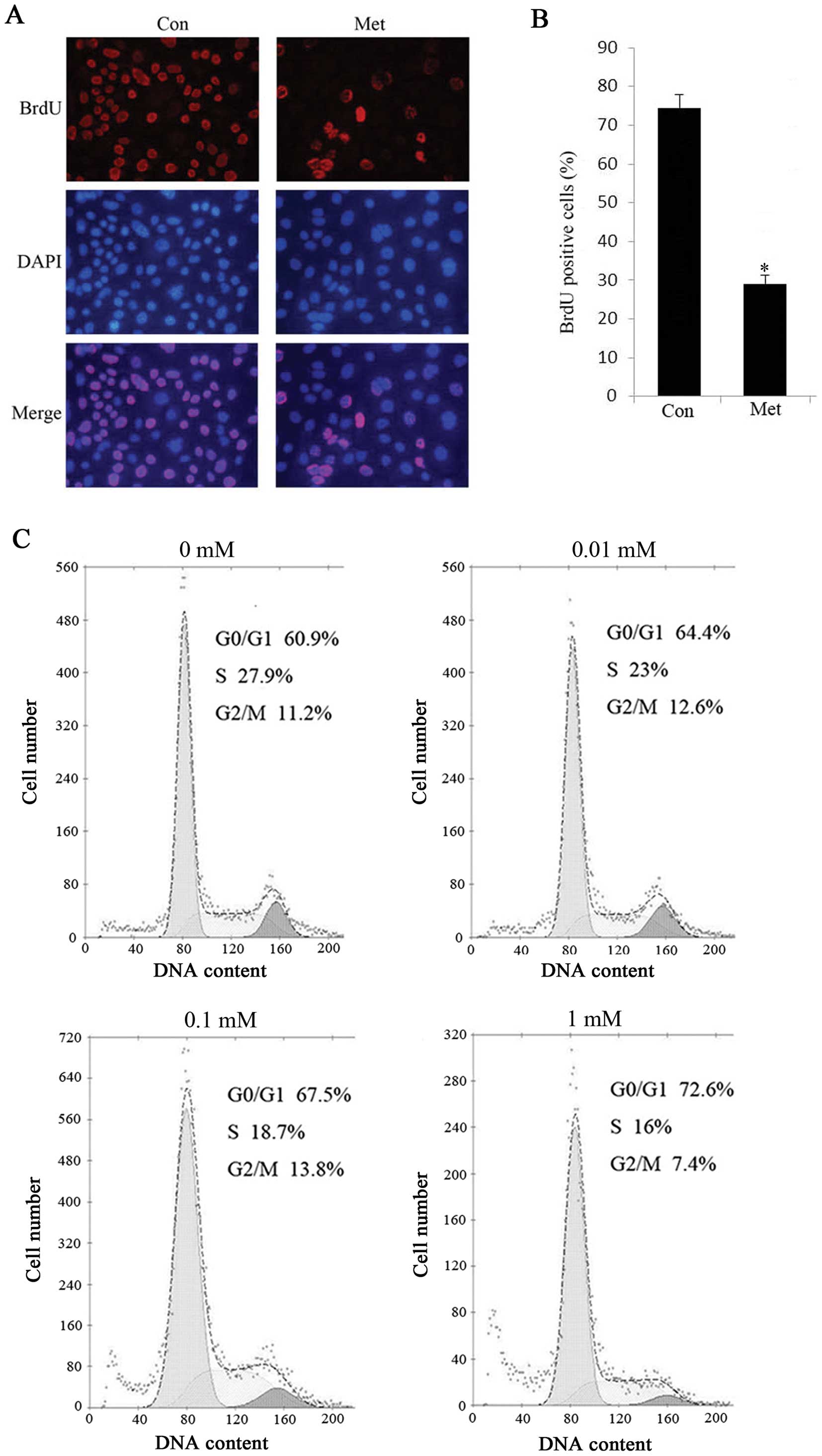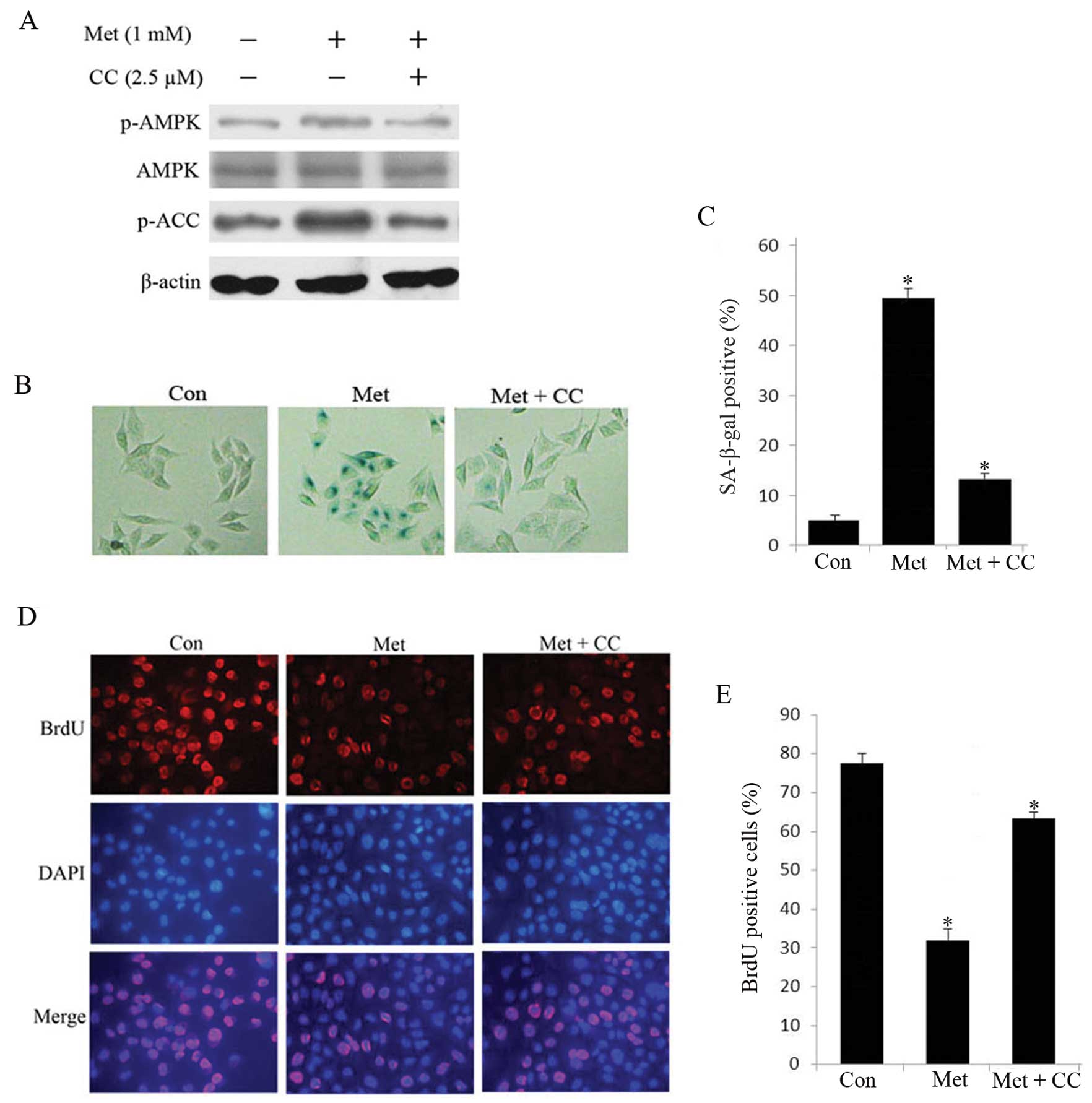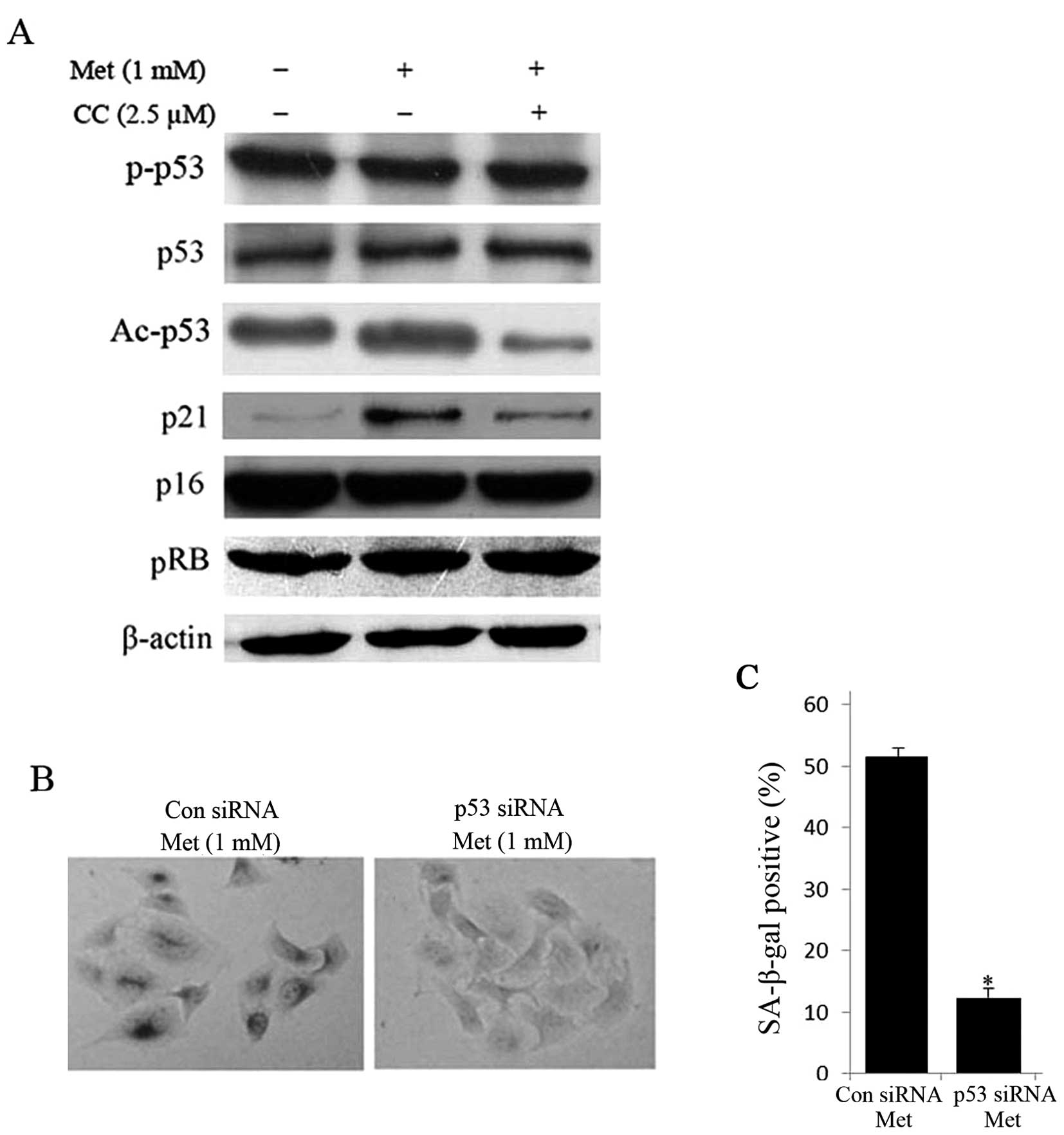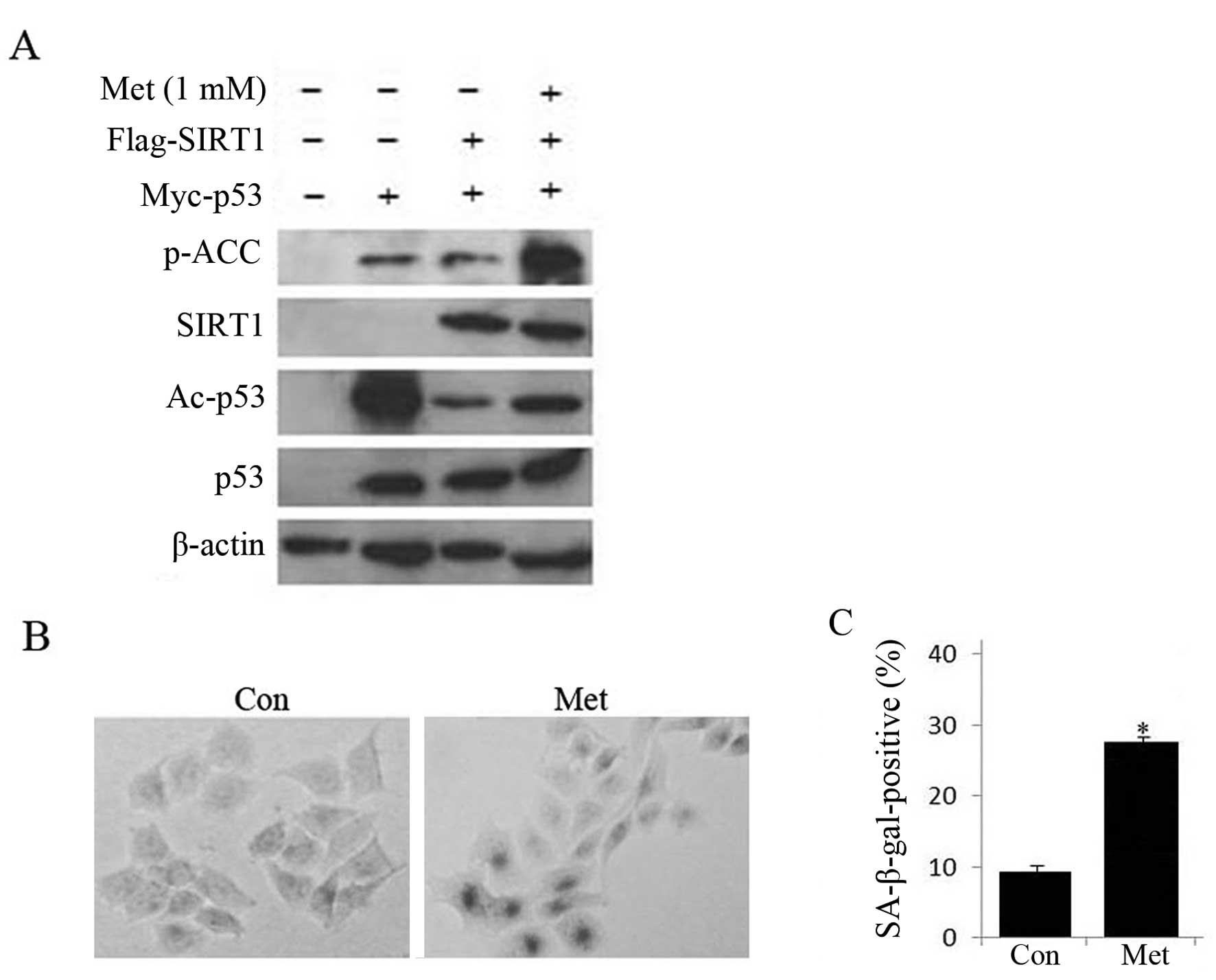Low concentration of metformin induces a p53-dependent senescence in hepatoma cells via activation of the AMPK pathway
- Authors:
- Published online on: August 23, 2013 https://doi.org/10.3892/ijo.2013.2077
- Pages: 1503-1510
Abstract
Introduction
Cellular senescence, an irreversible state of cell growth arrest, is an important physiological mechanism in protecting cells against malignant transformation (1–3). In primary mammalian cells, senescence can be triggered by diverse cellular stressors (4). Although senescent cells are non-dividing, they are still metabolically active with several distinctive morphological changes, such as enlarged and flatted cell shape and can be visualized with a widely accepted and used marker, senescence-associated beta-galactosidase (SA-β-gal) staining (5,6). In murine liver carcinoma, p53 restoration induces senescence and leads to tumor regression (7). Therefore, tailored pro-senescence therapies in tumor cells is an attractive approach to cancer treatment.
Hepatocellular carcinoma (HCC) is the fifth most common neoplasm, accounting for >90% primary liver cancer and also the second leading cause of cancer death worldwide (8). More than 70% patients with HCC at the time of diagnosis are not suitable for surgical resection due to the lack of early symptoms. Conventional cytotoxic chemotherapy or (and) radiotherapy dose not significantly prolong survival or improve the quality of life for patients with advanced HCC. The development of efficacious therapeutic strategies for the treatment or chemoprevention of HCC would have a dramatic effect on those who have been diagnosed with or are at risk for HCC.
Metformin (1,1-dimethylbiguanide hydrochloride), a biguanide derivative, has emerged as potential anti-neoplastic agent in the prevention and treatment of HCC (9). Moreover, several studies have demonstrated that metformin has an inhibitory effect on hepatoma cell growth both in vitro and in vivo (10–12). Due to its potential as a promising candidate for cancer therapeutics, metformin has garnered much interest and several mechanisms of action have been identified such as induction of cell cycle arrest and apoptosis as well as inhibition of epithelial to mesenchymal transition in certain cancers (13–15). However, to date little is known about the possible effect of metformin on cellular senescence and the mechanism of action of metformin.
In the present study, we investigated the effect of metformin on hepatoma cell proliferation and mechanisms responsible for its action. We discovered that low concentration of metformin retarded proliferation of hepatoma cells and induced phenotypic changes typically associated with cellular senescence. The induction of senescence-like growth arrest is related to activation of AMPK pathway. Importantly, these findings may help to explain the differential impact of metformin and provide a potential strategy of promoting senescence for adjuvant treatment of HCC.
Materials and methods
Materials and cells
Metformin was purchased from Sigma-Aldrich (St. Louis, MO, USA). Compound C, an AMPK inhibitor, was supplied by Calbiochem (La Jolla, CA, USA). Antibodies against AMPK, p-AMPK (Thr172), p-ACC (Ser79), p53, acetyl-p53 (Lys382), p-p53 (Ser15), p21waf1/cip1, p16INK4A, p-RB (Ser795), PARP and SIRT1 were provided by Cell Signaling Technology (Danvers, MA, USA). The antibody specially recognizing Dec1 was obtained from Santa Cruz Biotechnology, Inc. (Santa Cruz, CA, USA). p53 and control siRNA were purchased from Cell Signaling Technology. Human liver cancer cell lines HepG2 and Bel-7402 (both bearing wild-type p53), a gift from Professor X. Guo (Sun Yat-Sen University, Guangzhou, China) were maintained in RPMI-1640 supplied with 10% fetal bovine serum and 1% penicillin/streptomycin (Invitrogen, Carlsbad, CA, USA). Cultures were incubated at 37°C and 5% CO2. Logarithmically growing cells were treated with the indicated concentrations of metformin or compound C for 48 or 24 h and then replaced with regular culture medium.
MTS assay
Hepatoma cells were seeded on 96-well plates at 5×103 cells per well. After different treatments, 20 μl of MTS reagent was added to each well using a multi-well pipettor and incubated for 3 h. Cell proliferation was assessed by measuring the absorbance at 490 nm using a Bio-Tek Synergy2 microplate reader. Each experiment was repeated 3 times.
BrdU incorporation assay
In cells treated with metformin, compound C or siRNA, BrdU incorporation was assayed using a commercial kit (Cell Signaling Technology). Briefly, cells were grown on 22-cm coverslips and incubated with anti-BrdU primary antibody at 4°C overnight. The cells were then washed with PBS and processed for immunofluorescence. Cells were mounted with Prolong Gold Antifade Reagent (Invitrogen, Eugene, OR, USA) and visualized under a fluorescence microscope (Leica CTR6000) at ×100 or ×200 magnification.
Annexin V/propidium iodide staining assays
To detect whether metformin induces cell apoptosis, we stained the treated cells with an Annexin V kit (Sigma-Aldrich). Briefly, 1×106 hepatoma cells were treated with different concentration of metformin for 48 h, stained with Annexin V/propidium iodide (PI) and then subjected to FACSCalibur cytometry (BD Bioscience, Mountain View, CA, USA).
Cell cycle analysis
Cell cycle distribution was performed as previously described (12). The cells were harvested after treatment with metformin, then fixed with 70% cold ethanol and stained with 50 mg/ml PI followed by RNase A treatment for 30 min at room temperature. DNA content was analyzed with a FACSCalibur cytometer (BD Bioscience). The population of cells in each phase was determined by using ModFit LT software (BD Bioscience).
Senescence-associated β-galactosidase (SA-β-gal) staining
SA-β-gal staining was performed as previously described (16). In brief, hepatoma cells were seeded in 6-well plates and fixed with 4% formaldehyde for 5 min at room temperature. The cells were then washed with PBS and incubated with fresh SA-β-gal staining solution containing 1.0 mg/ml X-galactosidase (Stratagene, La Jolla, CA, USA) at 37°C for 16–18 h to visualize SA-β-gal staining.
Western blotting
Cell extracts were prepared by lysing the cells in RIPA buffer and protein concentration was quantified through BCA assay. Protein sample (50 μg) was subjected to 10% SDS-polyacrylamide gel electrophoresis (SDS-PAGE) and transferred onto polyvinylidene difluoride membrane (Millipore Corp., Billerica, MA, USA). The membranes were blocked with 5% non-fat milk in PBS containing 0.05% Tween-20 for 1 h at room temperature and then incubated with specific primary antibodies. Detection of specific proteins was performed by enhanced chemiluminescence reagent (Thermo Scientific, Rockford, IL, USA).
Transfection of siRNA
Transfection of hepatoma cells with siRNA was carried out using Lipofectamine 2000, according to the manufacturer’s instructions (Invitrogen). Briefly, aliquots of 1.5×104 cells were seeded on 6-well plates and grown to 50–70% confluence before transfection. Cells were then transfected with 60 pmol p53 siRNA for 6 h plus 1 μl Lipofectamine in Opti-MEM® I medium. Subsequently, the transfection medium was replaced by fresh regular culture medium. After 48 h of incubation, protein levels were detected by western blot analysis.
Statistical analysis
The data are presented as the mean ± standard deviation and statistical comparisons between groups were done using one-way analysis of variance followed by Student’s t-test. P<0.05 was considered statistically significant.
Results
Effect of metformin on hepatoma cell proliferation and apoptosis
In this study, metformin caused inhibition of cell proliferation in a dose-dependent manner (Fig. 1A), which is consistent with previous observations (11,12). In addition, several studies have shown that metformin has pro-apoptotic effects on hepatoma cells at concentration of ≥5 mM (11,12). In the present study, 10–50 mM metformin caused a significant induction of apoptosis as evidenced by Annexin V staining and accumulation of cleavage PARP protein. However, low dose of metformin (0.01–1 mM) did not (Fig. 1B and C). Interestingly, 1 mM metformin was sufficient to impair HepG2 cell proliferation without apparent induction of apoptosis. Similar results were obtained in another hepatoma cell line Bel-7402 (data not shown) following metformin treatment, indicating that the effect is not cell line specific. On the basis of these findings, we concluded that metformin exerts a multiphase effect on hepatoma cells, with low dose leading to a sustained decrease in proliferation, and triggering of a higher rate of apoptotic cell death.
Low doses of metformin induces cellular senescence in hepatoma cells
HepG2 cells exposed to low concentration of metformin were characterized by enlarged and flatted cell phenotype in our initial observation (data not shown), which is likely associated with cellular senescence (17), therefore we sought to determine whether low doses of metformin might induce senescence in hepatoma cells. Indeed, low concentration of metformin induced HepG2 cell senescence in a dose-dependent manner, as evident by increased SA-β-gal activity, a universal marker of cellular senescence (Fig. 2A and B). Moreover, protein expression level of Dec1, one of the established markers for senescence (18) was enhanced in response to metformin compared with controls (Fig. 2C), which is in accordance with SA-β-gal staining results. Additionally, HepG2 cells treated with 1 mM metformin exhibited a marked decrease in BrdU incorporation, a marker of cell proliferation (Fig. 3A and B). Of note, when we treated HepG2 cells with metformin for 48 h and either metformin was withdrawn or continued the treatment for another 72 h, there was no significant difference in cell viability between the persistent metformin-treated cells and the metformin-removed cells (data not shown), suggesting that metformin-induced proliferation arrest is irreversible even when the drug is withdrawn. To further clarify the effect of metformin on cellular senescence, we investigated the cell cycle progression in the absence or presence of metformin by flow cytometric analysis. The results indicated that the percentage of G0/G1 phase cells was significantly increased in metformin treated cells and correspondingly, the cell population of G2/M was declined compared with the controls (Fig. 3C). Similarly, we observed senescence in Bel-7402 cells with metformin treatment (data not shown), indicating that low doses of metformin triggered senescence in hepatoma cells.
Metformin induces hepatoma cell senescence by activating AMPK signaling
Next, we sought to determine the mechanism by which metformin induced senescence in hepatoma cells. Since 1 mM metformin caused significant induction of cellular senescence without apparent induction of apoptosis, we treated HepG2 cells with 1 mM metformin in the subsequent experiments. We detected the expression of phosphorylation of AMPK and its downstream gene ACC through western blot analysis. In metformin-treated senescent HepG2 cells, robust phosphorylation of AMPK and ACC was observed compared with untreated cells (Fig. 4A), indicating that activation of AMPK signaling cascade are relevant to the senescence in HepG2 cells. To further confirm the relationship between HepG2 cell senescence and AMPK activation, we examined the effects of compound C, a specific AMPK inhibitor, on senescence in HepG2 cells. As shown in Fig. 4B–E, compound C reduced metformin-stimulated SA-β-gal-positive cells and restored proliferation. In addition, the protein level of p-AMPK and p-ACC was attenuated compared to untreated cells (Fig. 4A). These results suggest that AMPK pathway plays a crucial role in metformin-induced senescence in hepatoma cells.
It is well known that senescence is mainly manipulated through canonical p53/p21 and p16/pRB signaling pathway (19). Thus, we sought to determine whether activation of AMPK pathway depends on these two pathways. Interestingly, the acetylation of p53 (Ac-p53) and p21 were increased in metformin-treated HepG2 cells, while the protein expression of phosphorylation of p53 at Serine 15, p53, p16 and pRB was unaltered (Fig. 5A). On the other hand, treatment with compound C for 24 h obviously reduced protein expression of Ac-p53 and p21 compared with untreated cells (Fig. 5A). Furthermore, siRNA-mediated knockdown of p53 diminished metformin-induced SA-β-gal positive cells (Fig. 5B and C). These data imply that the activation of AMPK pathway is dependent on the p53.
As AMPK activation promotes acetylation of p53, we investigated whether SIRT1, a NAD-dependent protein deacetylase (20), was involved in the regulation of p53 transcriptional activity. Toward this goal, HepG2 cells were co-transfected with Myc-p53 and Flag-SIRT1 plasmid and then treated with metformin. As shown in Fig. 6, co-expression of SIRT1 and p53 significantly suppressed the level of acetylated p53, but 1 mM metformin treatment partially rescued the effect of SIRT1 on p53 acetylation and increased SA-β-gal staining, suggesting that activating AMPK by metformin treatment might inhibit the SIRT1 deacetylase activity on p53, resulting in promotion of HepG2 cell senescence.
Discussion
The role of senescence in suppressing tumor progression and as a determinant of the outcome of conventional anticancer therapies have indicated that pro-senescence therapies could be an alternative strategy for treating cancer (21,22). In contrast to apoptosis, driving cells to undergo senescence have fewer side effects related to cytotoxicity (23) and senescent tumor cells are efficiently eliminated by immune cells, resulting in efficient tumor progression (7), which might provide a more realistic approach for the chronic management of some cancers (2). Epidemiological and laboratory studies have shown that metformin has unanticipated cancer prevention and treatment activity in patients with HCC (24–26). However, the role of low doses of metformin action in HCC remains unclear. Hence, the aim of this study was to elucidate the effect of low concentration of metformin on hepatoma cell proliferation and a more detailed understanding of the mechanisms as well as to ascertain the feasibility of metformin being used as a promising adjuvant agent for treatment or chemoprevention in HCC.
Many studies suggest a role of AMPK signaling pathway in the senescence process. For instance, senescence is accompanied by a marked elevation of AMPK activity in senescent fibroblasts (27). Activation of AMPK contributes to premature aging phenotype of Zmpste24−/− mice (28). In addition, AMPK inhibition resulted in significant anti-senescence effect to vascular smooth muscle cells (29). However, the role of AMPK in cancer cell senescence was largely unknown. Our present study revealed that AMPK activation is involved in promoting senescence in hepatoma cells exposed to low doses of metformin. Inhibition of AMPK activity by compound C led to profoundly decreased senescence and rescued proliferation of hepatoma cells. These results indicated that AMPK plays an important role in regulating senescence in human hepatoma cells.
Recently, it has been shown that activation of AMPK by AICAR (5-amino-1-β-Dffff-ribofuranosyl-imidazole-4-carboxamide) leads to cell cycle arrest in a human HCC cell line via activating p53-p21 pathway (30). Additionally, Jones et al (31) found AMPK activation promotes p53 activity through phosphorylation at Serine 15 and this phosphorylation event is essential for mediating the effects of AMPK on p53-dependent mouse embryonic fibroblast cell cycle arrest. However, persistent activation of AMPK results in accelerated p53-dependent cellular senescence. By contrast, in this study we demonstrated although the levels of phosphorylation of p53 at Serine 15 were not changed in metformin-treated senescent hepatoma cells, the levels of p53 acetylation at Lys382 were significantly increased, suggesting that AMPK activation is capable of inducing cellular senescence by stabilizing p53 via promoting p53 acetylation.
Previously, Luo and colleagues (32) found that SIRT1 can directly deacetylate p53 both in vitro and in vivo and promotes cell survival under stress. Furthermore, another independent study (33) reported that p53 is among the first non-histone substrates identified to be functionally involved in the anti-senescence activity of SIRT1. SIRT1 antagonizes p53-induced cellular senescence in primary mouse embryonic fibroblasts by interacting with and acetylating p53. Consistently, we present evidence that co-expression of SIRT1 and p53 remarkably impaired p53 acetylation, while low doses of metformin in part suppressed SIRT1-mediated deacetylation and enchanced the SA-β-gal staining, implying that SIRT1 is a negative regulator of p53 and is associated with the metformin-mediated senescence in hepatoma cells. As is known, AMPK and SIRT1 are the two key energy sensor systems regulating cell survival, proliferation and senescence (34). AMPK and SIRT1 are vital links in an orchestrated network regulating cellular senescence. For example, SIRT1 was able to prevent endothelial senescence triggered by LKB1-dependent AMPK activation, implying that anti-senescence effect of SIRT1 is achieved at least in part by regulating the LKB1-AMPK pathway (35). However, whether AMPK counter-regulates SIRT1 in mammalian cellular senescence is still unknown. Intriguingly, in our preliminary study, interaction between AMPK and SIRT1 was clearly demonstrated using co-immunoprecipitation in cell-free systems (data not shown). Further studies are required to determine whether a possible regulation of SIRT1 by AMPK is involved in metformin-stimulated senescence in hepatoma cells.
In conclusion, the data provide evidence, for the first time, that exposure of hepatoma cells to low doses of metformin results in the induction of senescence instead of apoptosis and this correlates with activation of the senescence-promoting AMPK pathway in a p53-dependent manner. These findings imply that metformin-induced senescence might be a viable and relatively safe option for developing HCC adjuvant therapeutics.
Acknowledgements
We would like to thank Dr Kai Luo, Min Deng, Min Hou and Min Liang for technical assistance and suggestions. This study was supported by grant A20110231 from Star of Science and Technology of Guangzhou and 20121A011163 from Health Bureau of Guangzhou.
References
|
Collado M, Blasco MA and Serrano M: Cellular senescence in cancer and aging. Cell. 130:223–233. 2007. View Article : Google Scholar : PubMed/NCBI | |
|
Collado M and Serrano M: Senescence in tumors: evidence from mice and humans. Nat Rev Cancer. 10:51–57. 2010. View Article : Google Scholar : PubMed/NCBI | |
|
Kang TW, Yevsa T, Woller N, et al: Senescence surveillance of pre-malignant hepatocytes limits live cancer development. Nature. 479:547–551. 2011. View Article : Google Scholar : PubMed/NCBI | |
|
Kuilman T, Michaloglou C, Mooi WJ and Peeper DS: The essence of senescence. Genes Dev. 24:2463–2479. 2010. View Article : Google Scholar : PubMed/NCBI | |
|
Dimri GP, Lee X, Basile G, et al: A biomarker that identifies senescent human cells in culture and in aging skin in vivo. Proc Natl Acad Sci USA. 92:9363–9367. 1995. View Article : Google Scholar : PubMed/NCBI | |
|
Debacq-Chainiaux F, Erusalimsky JD, Campisi J and Toussaint O: Protocols to detect senescence-associated beta-galactosidase (SA-βgal) activity, a biomarker of senescent cells in culture and in vivo. Nat Protoc. 4:1798–1806. 2009.PubMed/NCBI | |
|
Xue W, Zender L, Miething C, et al: Senescence and tumour clearance is triggered by p53 restoration in murine liver carcinomas. Nature. 445:656–660. 2007. View Article : Google Scholar : PubMed/NCBI | |
|
Jemal A, Bray F, Center MM, Ferlay J, Ward E and Forman D: Global cancer statistics. CA Cancer J Clin. 61:69–90. 2011. View Article : Google Scholar | |
|
Pollak M and Gonzalez-Angulo AM: Metformin and hepatic carcinogenesis. Cancer Prev Res. 5:500–502. 2012. View Article : Google Scholar : PubMed/NCBI | |
|
Qu Z, Zhang Y, Liao M, Chen Y, Zhao J and Pan Y: In vitro and in vivo antitumoral action of metformin on hepatocellular carcinoma. Hepatol Res. 42:922–933. 2012. View Article : Google Scholar : PubMed/NCBI | |
|
Chen HP, Shieh JJ, Chang CC, et al: Metformin decreases hepatocellular carcinoma risk in a dose-dependent manner: population-based and in vitro studies. Gut. 62:606–615. 2013. View Article : Google Scholar : PubMed/NCBI | |
|
Liu J, Hou M, Yuan T, et al: Enhanced cytotoxic effect of low doses of metformin combined with ionizing radiation on hepatoma cells via ATP deprivation and inhibition of DNA repair. Oncol Rep. 28:1406–1412. 2012.PubMed/NCBI | |
|
Zhou G, Myers R, Li Y, Chen Y, et al: Role of AMP-activated protein kinase in mechanism of metformin action. J Clin Invest. 108:1167–1174. 2001. View Article : Google Scholar : PubMed/NCBI | |
|
Ben Sahra I, Regazzetti C, Robert G, et al: Metformin, independent of AMPK, induces mTOR inhibition and cell-cycle arrest through REDD1. Cancer Res. 71:4366–4372. 2011.PubMed/NCBI | |
|
Del Barco S, Vazquez-Martin A, Cufí S, et al: Metformin: multi-faceted protection against cancer. Oncotarget. 2:896–917. 2011.PubMed/NCBI | |
|
Wang W, Yang X, López de Silanes I, Carling D and Gorospe M: Increased AMP:ATP ratio and AMP-activated protein kinase activity during cellular senescence linked to reduced HuR function. J Biol Chem. 278:27016–2723. 2003. View Article : Google Scholar : PubMed/NCBI | |
|
Cairney CJ, Bilsland AE, Evans T, et al: Cancer cell senescence: a new frontier in drug development. Drug Discov Today. 17:269–276. 2012. View Article : Google Scholar : PubMed/NCBI | |
|
Qian Y, Zhang J, Yan B and Chen X: DEC1, a basic helix-loop-helix transcription factor and a novel target gene of the p53 family, mediates p53-dependent premature senescence. J Biol Chem. 283:2896–2905. 2007. View Article : Google Scholar : PubMed/NCBI | |
|
Mallette FA, Goumard S, Gaumont-Leclerc MF, Moiseeva O and Ferbeyre G: Human fibroblasts require the Rb family of tumor suppressors, but not p53, for PML-induced senescence. Oncogene. 23:91–99. 2004. View Article : Google Scholar : PubMed/NCBI | |
|
Guarente L: Sir2 links chromatin silencing, metabolism and aging. Genes Dev. 14:1021–1026. 2000.PubMed/NCBI | |
|
Nardella C, Clohessy JG, Alimonti A and Pandolfi PP: Pro-senescence therapy for cancer treatment. Nat Rev Cancer. 11:503–511. 2011. View Article : Google Scholar : PubMed/NCBI | |
|
Acosta JC and Gil J: Senescence: a new weapon for cancer therapy. Trends Cell Biol. 22:211–219. 2012. View Article : Google Scholar : PubMed/NCBI | |
|
Ewald JA, Desotelle JA, Wilding G and Jarrard DF: Therapy-induced senescence in cancer. J Natl Cancer Inst. 102:1536–1546. 2010. View Article : Google Scholar : PubMed/NCBI | |
|
Aljada A and Mousa SA: Metformin and neoplasia: implications and indications. Pharmacol Ther. 133:108–115. 2012. View Article : Google Scholar : PubMed/NCBI | |
|
Lee MS, Hsu CC, Wahlqvist ML, Tsai HN, Chang YH and Huang YC: Type 2 diabetes increases and metformin reduces total, colorectal, liver and pancreatic cancer incidence in taiwanese a representative population prospective cohort study of 800,000 individuals. BMC Cancer. 11:202011. View Article : Google Scholar | |
|
Zhang ZJ, Zheng ZJ, Shi R, Su Q, Jiang Q and Kip KE: Metformin for liver cancer prevention in patients with type 2 diabetes: a systematic review and meta-analysis. J Clin Endocrinol Metab. 97:2347–2353. 2012. View Article : Google Scholar : PubMed/NCBI | |
|
Zwerschke W, Mazurek S, Stöckl P, Hütter E, Eigenbrodt E and Jansen-Dürr P: Metabolic analysis of senescent human fibroblasts reveals a role for AMP in cellular senescence. Biochem J. 376:403–411. 2003. View Article : Google Scholar : PubMed/NCBI | |
|
Mariño G, Ugalde AP, Salvador-Montoliu N, et al: Premature aging in mice activates a systemic metabolic response involving autophagy induction. Hum Mol Genet. 17:2196–2211. 2008.PubMed/NCBI | |
|
Sung JY, Woo CH, Kang YJ, Lee KY and Choi HC: AMPK induces vascular smooth muscle cell senescence via LKB1 dependent pathway. Biochem Biophys Res Commun. 413:143–148. 2011. View Article : Google Scholar : PubMed/NCBI | |
|
Imamura K, Ogura T, Kishimoto A, Kaminishi M and Esumi H: Cell cycle regulation via p53 phosphorylation by a 5′-AMP activated protein kinase activator, 5-aminoimidazole-4-carboxamide-1-beta-D-ribofuranoside, in a human hepatocellular carcinoma cell line. Biochem Biophys Res Commun. 287:562–567. 2001. | |
|
Jones RG, Plas DR, Kubek S, et al: AMP-activated protein kinase induces a p53-dependent metabolic checkpoint. Mol Cell. 18:283–293. 2005. View Article : Google Scholar : PubMed/NCBI | |
|
Luo J, Nikolaev AY, Imai S, et al: Negative control of p53 by Sir2alpha promotes cell survival under stress. Cell. 107:137–148. 2001. View Article : Google Scholar : PubMed/NCBI | |
|
Langley E, Pearson M, Faretta M, et al: Human SIR2 deacetylates p53 and antagonizes PML/p53-induced cellular senescence. EMBO J. 21:2383–2396. 2002. View Article : Google Scholar : PubMed/NCBI | |
|
Wang Y, Liang Y and Vanhoutte PM: SIRT1 and AMPK in regulating mammalian senescence: a critical review and a working model. FEBS Lett. 585:986–994. 2011. View Article : Google Scholar : PubMed/NCBI | |
|
Zu Y, Liu L, Lee MY, et al: SIRT1 promotes proliferation and prevents senescence through targeting LKB1 in primary porcine aortic endothelial cells. Circ Res. 106:1384–1393. 2010. View Article : Google Scholar : PubMed/NCBI |
















